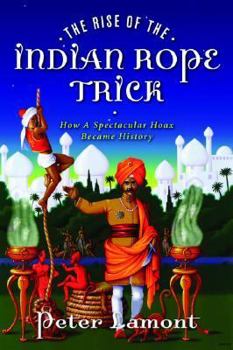The Rise of the Indian Rope Trick: How a Spectacular Hoax Became History
Select Format
Select Condition 
Book Overview
A rope rises up into the air. A boy climbs up the rope and when the boy gets to the top he vanishes into thin air, explains Peter Lamont, winner of the Jeremy Dalziel prize in British History, and... This description may be from another edition of this product.
Format:Hardcover
Language:English
ISBN:1560256613
ISBN13:9781560256618
Release Date:November 2004
Publisher:Basic Books
Length:265 Pages
Weight:1.05 lbs.
Dimensions:1.1" x 5.8" x 8.3"
Customer Reviews
2 ratings
The Trick That Never Was That Became a Real Trick
Published by Thriftbooks.com User , 19 years ago
You wouldn't have thought that a magic trick that never was is the best known magical trick of all time. Peter Lamont uses this trick as the foundation of a search into magic tricks of all kinds, but especially tricks from India. His search has taken him back into history and finally a trip to India doing research. Extensively researched and referenced this is a very interesting trip into the explanation of magic. When I first picked it up, because of the title, I expected to put it down again quickly. Instead I found the writing style and the content to be fascinating and didn't put it down. Every so often I get some kind of story in an e-mail describing something that just makes so much sense that it had to have happened. It's nice to know that such urban legends didn't just start with the Internet, but a long time ago. The Indian Rope Trick - a totally made up story - in Chicago - nothing to do with India at all. Then magicians had to come up with a way to do it. Strange world.
An Illusory Illusion
Published by Thriftbooks.com User , 19 years ago
Perhaps you have seen a magician pull a rabbit out of a demonstrably empty hat. You may have seen the classic magical trick of sawing a woman in half. And perhaps you have seen the Indian rope trick: the conjurer, standing in an open field, throws one end of a rope into the air, where defying gravity, it stays, and a boy comes to climb up the rope, reaches the top, and disappears. No, you have not seen that one, perhaps, but it is as famous as the others and has caused a century of wonder, perhaps not from audiences but from those who have tried to see the illusion and tried to learn how it was done. In _The Rise of the Indian Rope Trick: How a Spectacular Hoax Became History_ (Thunder's Mouth Press), Peter Lamont, a magician and an academic researcher on the performance of magic, has written a hugely entertaining book about the most legendary and exotic of magic tricks. "A legend is very much like an illusion," he writes, "more interesting and invariably more attractive than reality." We need legends, and this one is so colorful and mysterious, Lamont's careful probing and deflating make it even more attractive. The amazing truth is that there never was any Indian rope trick, and it has almost nothing to do with India. It was the invention of a loyal American, a journalist who later went on to become the head of the US Secret Service. John Elbert Wilkie was a reporter for the _Chicago Tribune_, and in 1890 he published an anonymous article describing the rope trick as seen in India, and how it was done. He made it all up. There were those who spoke up, certain that people were seeing the rope trick before 1890, but there are no accounts of the trick before that time. A few weeks later, the _Tribune_ published a confession that the story was a hoax, but newspapers across America and Europe were spreading the story, while the retraction got nowhere. As Lamont writes, "A legend does not survive on accuracy." The community of magicians, and those fascinated by their effects, became split between those who were convinced that the rope trick was a real illusion and those who thought it an illusory illusion. The efforts of those who believed the trick to be real have been extensive. A photograph was finally produced of the trick in 1919, but it turned out to be the far more prosaic trick of a boy balancing on a pole. People had seen the trick in India, but they turned out to be people who were reported as seeing it by other people, the familiar "friend of a friend" basis of countless urban legends. There were those who claim to have seen the trick themselves. Many of them took decades to speak up and say that they had actually seen the trick performed, but a psychologist has found that the memories get elaborated, with fancier versions being recalled the more distant the memory is. One particular elaboration has outdone Wilkie's conception, and has had its own life, supporters, and detractors. This is the version in which the boy




